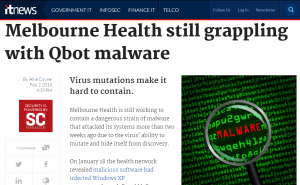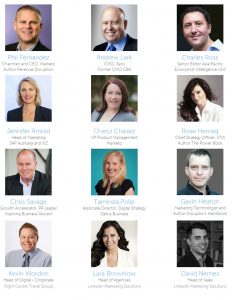When I started this blog ten years ago, it began with a rant. A call to action. It was a poetic exploration of what it might mean to focus on your customer above all else. It was also a warning about what would happen if businesses refused to do so.
There are more to the words of consumers than the corporations expect.
We huddle in groups, in chat rooms.
We explode on the keyboards of a million call centres.
Our imagination is unheard of. Our thoughts cancel out the process.
We are your hearts and your minds.
We are everywhere, all places, all over the shop.
Fast forward ten years and over 2200 articles later, and it feels like we might be making a little progress on this transformation in business that we call “digital”.
When I spoke at Telstra’s Vantage conference just a couple of months ago, there was a palpable sense that a shift was underway in the way that Australia’s largest telecommunications company was presenting itself. It was more assertive. Less about cables and wires. More about services and transformation. About helping customers solve business problems.
And with the Telstra Digital Summit, we are seeing a stronger Telstra yet again. Also see Joanne Jacobs’ live blog.
Kicking off with Andy Penn, CEO of Telstra
It was the most comprehensive display of digital leadership that we have seen from Telstra. In fact, I would be hard pressed to think of another company that is making such a concerted shift. There was context setting from Telstra CEO, Andy Penn and newly minted Minister for Communications, Mitch Fifield, sprinkled with humour, references to 80s music and examples of how Telstra is shifting from its telco base to become more of a “technology business”. There was still a reliance on numbers over storytelling and “core” messaging than vision, but it’s a new dance that Telstra is learning and like anything at this scale, it takes time.
A vision of the future with Robert Scoble
Peering into the near future, Robert Scoble and Kathryn Parsons talked about the way technology is empowering people, students and businesses to transform their own futures. Robert, in particular took us into a world whose future is inextricably linked to technology. Part geek fanboy and part techno-utopian, Robert’s exciting new world is populated by ever more deeply connected, yet strangely disembodied, individuals shuttling between meetings in driverless cars and adventures in virtual reality. Robert is an expert at connecting out-of-this-world market valuations for new technology with a vision for the future that is yet to be created, but in a country that is struggling to spread 20th Century broadband copper across its vast distances, it feels like it may take Australia longer than most to reach this new future.
Decoding the future with Kathryn Parsons
The energy of Kathryn Parsons, CEO of Decoded is palpable. A great storyteller, she effortlessly weaves her own story with that of Decoded – the accelerated learning program designed to get you up and going with coding, data and technology in a day. Soon to be launching in Australia, Decoded’s launch reinforces the fact that education is one of the great opportunities of the early 21st Century. And just as Australia exports a substantial amount of education to overseas markets, we are now seeing more overseas businesses eyeing the Australian markets keenly. Joining the US-based General Assembly, along with almost all the universities, Decoded brings a rapid sense of flair to adult learning. It will be interesting to see the ripples as they roll out here.
Enterprises learning to dance – Telstra’s Muru-D accelerator
Annie Parker, founder of Telstra’s startup accelerator, Muru-D, showcased two of the current businesses working through the program. When I first saw Holly Cardew talk about her Pixc business, it was all images, and online products. Today, just months later, it’s storefronts, investments and ecommerce – a dramatic and welcome move up the value chain. And Cate Hull’s vision for FreightExchange – an uber for excess freight capacity – remains clear and eminently viable as it did on day one.
Dazzled by data – Lithium’s Rob Tarkoff
Rob Tarkoff, CEO of Lithium dazzled the audience with insight, data and a world of big data experience. He toyed with the audience – testing our understanding of Daniel’s Market Theory (ie there is no theory, Daniel is his son) – going on to explain how the “born digital” generation are already exhibiting different behaviours and expectations from businesses and communities.
The rear view from out in front – Uber in Australia with David Rohrsheim
Uber’s David Rohrsheim was a crowd favourite, riding the wave of popularity that Uber is experiencing in Australia. When he asked how many in the audience had taken an Uber in the last week, almost the whole audience raised their hand. Here, David was preaching to his choir. This is where I hoped for a little more than the “why Uber is so uber”, but the audience certainly loved the storytelling.
X marks the spot with Brian Solis
After lunch is one of the most challenging speaking slots. Stepping into the void, Brian Solis took us the challenging landscapes of customer experience. As ever, Brian delivered insight in a smooth, easy to understand way. He is certainly one of the most accomplished speakers I have seen – polished, word perfect and authoritative. This time he was all these things, but with another quality. A depth or humility that I had not noticed previously. And this made his talk on X – customer experience, the crossroads for business – so good.
A brain on legs – Larry Marshall moving CSIRO to a new tune
We often say that “if you are the smartest person in the room, you need to get out”. And if this is the case, Larry Marshall, CEO of the CSIRO, is likely to find himself meeting-free for years to come. A great combination of entrepreneurialism and scientific chops, he has a clear vision for his 90 year old startup. Echoing Prime Minister, Malcolm Turnbull’s push for innovation and “agile government”, Larry challenged not only the audience but his own teams – “we have to be beta all the time”.
Telstra’s digital journey with Kartsen Wildberger
Rounding out the day was Telstra Group Executive, Karsten Wildberger sharing part of the Telstra digital journey. He touched on the challenges as well as some of the wins. It was refreshing to hear Karsten taking on the challenge of disruption, reframing it as opportunity rather than a threat – and encouraged the audience to think the same way. “Keep the customer at the centre of everything”, he urged.
Lethal Generosity with Shel Israel
The nicest man on the internet, and in many ways, it’s chronicler, Shel Israel, stepped us through what it takes to be “lethally generous”. And he is that in person. In fact, this is the title of his new book, generated to the millennial generation which he sees as the “greatest hope for the planet”. Listening to Shel, you hear not just a connection to technology but also a sense of the great underlying humanity which the technology was created to serve. As he says, “great customer service, even if it costs you a sale, gets you a customer for life”.
What the tweet – Twitter in Australia with Karen Stocks
Rounding out the day – in the last presentation before drinks – was local Twitter CEO, Karen Stocks. Given that the whole room could be categorised as “early adopters”, it was a shame that the presentation didn’t take us more into the future of Twitter. Clearly there was a lot of love in the room for Twitter and for Karen as CEO – and the segments on #likeagirl and Periscope reinforced the power and relevance that Twitter has created in the community. But it would have been great to hear more about their story with data and the tools that are available for businesses, their partnerships with companies like IBM or new features and capabilities coming down the track.
What’s next for the digital summit?
It was a broad brush conference and tied together many of the digital challenges in easy to consume, shorter, 20 minute snacks. There was fabulous diversity in the speaking line-up – it certainly wasn’t yet another conference dominated by MAMS (middle aged men in suits). The tweet stream provided some great, light hearted moments and worked to engage the audience across the day.
The faster pace also kept the audience focused and the energy levels high. And Telstra’s new-found confidence was surprisingly refreshing. Where once, their positioning was tinged with the air of superiority and arrogance, this conference felt like a more hands-on, let’s get things done attitude was pervading proceedings. Some ideas for the Telstra Digital Summit 2016 (hey ideas are free):
- More Australian speakers actually speaking about Australian businesses and conditions. It would be great to hear from Telstra business customers and the successes they are having. Some of the Telstra Business Awards winners had compelling stories and amazing digital outcomes. More of that please
- Breakout sessions for case studies and deep dives. There’s plenty of room in the exhibition area to have mini-talks on digital topics. This would be a great way for Telstra to showcase their depth of expertise and “lethal generosity”
- Connecting the audience. With around 1000 people attending the conference is now at the scale where connecting and networking with others is a challenge. With plenty of conference apps now available, it might be worth investigating something that helps connect people, ideas and opportunities.
Interestingly, while reading back over my blog, I found this article from 2008 urging Telstra to embrace an “almost unmatched opportunity” on the digital frontier. It has taken six years to hear these words from the lips of a Telstra CEO. Let’s hope that this forward momentum will continue.




